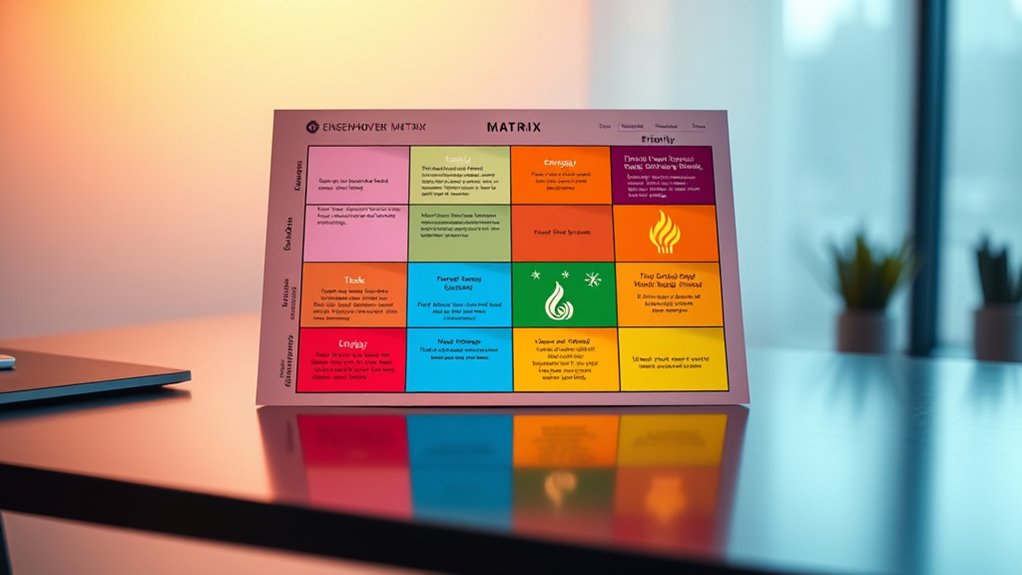By remixing the Eisenhower Matrix to include your energy levels, you can align your most demanding tasks with your peak focus times and handle less critical activities when your energy dips. This approach helps you work more efficiently, avoid burnout, and stay motivated long-term. Instead of just prioritizing by urgency and importance, you optimize your schedule based on your natural energy rhythms. Keep exploring to discover how this simple adjustment can transform your productivity.
Key Takeaways
- Integrate energy levels into the Eisenhower Matrix to prioritize tasks based on both importance, urgency, and personal energy peaks.
- Schedule high-focus tasks during high-energy periods and routine tasks during energy dips for optimal productivity.
- Use energy awareness to prevent burnout by aligning workload with natural energy fluctuations throughout the day.
- Adapt the traditional matrix dynamically, allowing flexibility based on daily energy rhythms and mental focus.
- Enhance overall efficiency by combining urgency, importance, and energy state for personalized, sustainable task management.

Ever wondered how to make the classic Eisenhower Matrix more effective for your productivity? The truth is, while the traditional matrix helps you prioritize tasks based on urgency and importance, it often overlooks a crucial factor: your energy levels. Incorporating energy levels into the matrix can revolutionize your time management and liberate new productivity hacks. When you understand how your energy fluctuates throughout the day, you can align your most demanding tasks with your peak performance periods, ensuring you get more done in less time. This approach transforms the standard matrix from a static prioritization tool into a dynamic system that adapts to your natural rhythms.
To start, recognize that not all tasks require the same level of energy or focus. High-energy periods—often in the morning or after a break—are ideal for tackling complex or essential tasks that demand deep concentration. Conversely, during low-energy times, you might prefer to handle routine or administrative duties that don’t require intense focus. By consciously scheduling your tasks based on your energy levels, you make your time management more efficient and effective. This simple tweak can help you avoid burnout and reduce procrastination, as you’re working with your natural flow instead of against it.
Schedule high-focus tasks during peak energy times for better productivity and less burnout.
Adding energy awareness to your priorities also means being honest about your capacity at any given moment. When you’re aware of your current energy state, you can make smarter decisions about what to focus on and when to take breaks. This is where productivity hacks come into play—like chunking similar tasks together during high-energy phases or using short, targeted breaks to recharge during low-energy periods. Using your energy as a factor in your decision-making process makes your workflow more sustainable and less stressful. It encourages you to listen to your body’s signals and adjust your plans accordingly, which increases your overall efficiency. Additionally, understanding retail store hours can help you plan your day better, especially if your tasks involve shopping or errands that are time-sensitive.
Furthermore, integrating energy levels into your task priorities helps you develop a more personalized productivity system. Instead of following a one-size-fits-all approach, you tailor your schedule to your unique energy patterns. Over time, you’ll identify your natural highs and lows, allowing you to optimize your daily routines. This added layer of insight enhances your time management skills and makes your productivity hacks more effective. The result is a more balanced, adaptable, and sustainable approach to work—one that respects your biological rhythms while helping you stay focused and motivated throughout the day.
Frequently Asked Questions
How Do Energy Levels Influence Decision-Making in the Matrix?
Energy levels greatly influence your decision-making process. When you’re aware of your energy, you can better assess the decision impact, choosing tasks that match your current state. High energy helps you tackle demanding tasks efficiently, while low energy suggests you should focus on easier or less urgent priorities. By integrating energy awareness into your decisions, you optimize productivity and reduce burnout, ensuring you handle priorities effectively based on your current energy levels.
Can the Matrix Be Adapted for Team Productivity?
You can adapt the matrix for team productivity by incorporating energy management and team dynamics. Assign tasks based on each team member’s energy levels, ensuring high-energy tasks go to those with peak focus. Use the matrix to visualize priorities collectively, fostering better collaboration. This approach helps balance workloads, boost motivation, and optimize overall efficiency, making your team more effective by aligning tasks with individual energy patterns and team dynamics.
What Tools Can Help Track Energy Levels Effectively?
To track energy levels effectively, you need tools that support energy tracking and productivity monitoring. Use apps like Toggl Track or RescueTime, which help you log energy fluctuations throughout your day. Consider wearable devices like Fitbit or Apple Watch for real-time data. Journaling or mood-tracking apps also work well, giving you insights into patterns. These tools help you make informed decisions, optimize work periods, and boost your overall productivity.
How Often Should Energy Levels Be Reassessed?
You should reassess your energy levels regularly to stay aware of fluctuations and motivation cycles. Ideally, check in at least once daily, such as in the morning and afternoon, to catch any energy dips or peaks. During busy or stressful days, consider more frequent check-ins. This helps you adjust your tasks accordingly, ensuring you work when your energy is high and conserve energy during lows, boosting overall productivity.
Are There Specific Industries Where This Remix Is Most Effective?
You might wonder if this remix works better in certain industries. It’s especially effective in sectors with dynamic workloads, like healthcare or tech, where energy levels fluctuate. By applying industry-specific applications, you can tailor sector-based prioritization, enhancing focus and productivity. This approach helps you allocate tasks based on both urgency and your current energy, ensuring you stay efficient and avoid burnout across different work environments.
Conclusion
Picture your tasks as vibrant colors on a canvas, each glowing with different energy levels. The Eisenhower Matrix Remix helps you sort these hues—urgent or not, important or not—while adding a splash of energy insight. With this tool, you’re the artist, choosing where to focus your brightest strokes and where to blend softer shades. As you organize, your workload becomes a vivid, balanced masterpiece—clear, focused, and energized, ready to come alive with purpose.









